
Get Cheap Car Insurance Quotes
Compare car insurance quotes and save $894* on average
On this page
- How car insurance works in Canada
- Types of car insurance coverage in Canada
- What is a car insurance quote?
- Where to get car insurance quotes
- How car insurance quotes are calculated
- Information you’ll need to get quotes
- Tips on how to get your cheapest car insurance quotes
- Car insurance coverage by province
- Average car insurance premiums by province (2014-2023)
- Frequently asked questions about Canadian car insurance
How to get the cheapest car insurance quotes from brokers in your city
Compare multiple auto insurance quotes in the time it takes to get just one.
Enter Postal Code
Enter your postal code to begin!

Enter Driver Details
Tell us a little bit about your vehicle, driving & car insurance history.

Compare Your Quotes
Compare your car insurance quotes from more than 50 top insurance companies.

Pick Your Policy
Pick the insurance policy that's right for you to connect directly with the insurance professional of your choice.
We've got hundreds of 5 star reviews
2,247 reviews on TrustPilot. See some of the reviews here.
Fran
Curtis
Robert Clarkson
Vincenzina Perri
Keith
Dev
Georgia
Shirley Munro
Hoang Tran
Alnoor
Michael Benninger
Gene
D on
Robert
Remonia Thompson
Rich
Luis
How car insurance works in Canada
Car insurance is mandatory in all provinces and territories.
There are serious consequences for driving without insurance. These include having your license suspended, your car impounded, and fines. In Ontario, the fines range from $5,000 to $50,000; in Alberta, they range from $2,875 to $20,000.
Plus, your insurance premiums will increase (the larger the fine, the more significant the increase).
So why aren’t other forms of insurance, like life and home insurance, not legally required? Car accidents take a toll on society. Victims likely wouldn't be able to access crucial support without mandatory insurance. Having a clear system for resolving disputes also ensures the courts don't get tied up.
Regulation at the federal and provincial levels
Insurance is regulated at both the federal and provincial levels.
The vast majority of the property and casualty insurance industry is federally regulated. The Insurance Companies Act governs all federally incorporated or registered insurance companies in Canada.
The Financial Consumer Agency of Canada (FCAC) is responsible for administering sections of the Act that deal with consumers' rights and monitoring insurance companies' compliance with the law.
The Office of the Superintendent of Financial Institutions (OSFI) regulates the solvency and financial soundness of property and casualty insurance companies.
Then, each province and territory have their own Superintendents of Insurance. These bodies regulate the products offered by insurers and their conduct in the marketplace (underwriting, rating, marketing practices, and handling of claims). The Financial Services Regulatory Authority of Ontario (FSRA) regulates the car insurance industry in Ontario. The Alberta equivalent is the Alberta Automobile Insurance Rate Board (AIRB).
Private vs. public car insurance markets
Canada has a patchwork of insurance markets. The provinces get to decide what delivery system they want, which is why some have private insurance markets (where you buy insurance directly from a company of your choice), and others have public insurance funded by taxpayers.
In the public system, insurance is dispensed by a Crown corporation (B.C., Saskatchewan, and Manitoba). Enrolment is automatic when you register a vehicle.
Quebec’s system can be described as semi-public. The public insurer only regulates insurance for bodily injuries, while private insurers provide physical damage and liability.
Provinces with private auto insurance systems (Ontario, Alberta, all the territories and Atlantic provinces) have laws preventing drivers with less than stellar driving and insurance records from being refused insurance coverage. This is called an all-comers rule.
The all-comers rule aims to stamp out business practices that block troubled drivers from getting a fair quote. Even with all-comer rules, if you have poor driving and insurance histories, your car insurance premium will be much higher than the average driver's.
And the differences between provinces don't stop there.
Tort vs. no-fault insurance
Tort insurance was once the dominant claims resolution methodology in Canada. A tort is a legal concept that refers to civil wrongs that inflict pain and damage to another person due to negligence.
Under a tort auto insurance system, some insurance accident benefits are included in a standard policy, but they’re limited compared to the benefits in no-fault systems. If someone else’s actions injure you, you must sue to cover your expenses.
No-fault coverage means you get comprehensive benefits regardless of who's at fault for causing the accident. In exchange, your right to sue for pain and suffering is limited.
Ontario, Nova Scotia, New Brunswick, Quebec, P.E.I., and B.C. operate under a no-fault system.
In Saskatchewan, you can decide whether you want a tort or no-fault accident benefits package.
Alberta doesn't fit into either the no-fault or tort category, either. It is a primarily tort-based system with some facets of a no-fault one. In 2022, the province introduced direct compensation for property damage (DCPD), which means your insurance company will pay for repairs to your vehicle if you're not at fault for a collision (no need to get lawyers involved). This type of coverage is usually only found in provinces with no-fault frameworks.
On the other hand, you can sue the at-fault party for damages in Alberta (a hallmark feature of the tort approach).
Geography and auto insurance
To get even more granular, insurance premiums are dictated by geographical boundaries.
Most insurance companies use postal codes to determine the boundaries. However, the province can get involved and set restrictions on rating territories.
Types of car insurance coverages in Canada
Since you can't legally operate a car without insurance in Canada —driving is an inherently risky activity — auto insurance policies are tightly regulated and standardized.
However, the provinces get to determine what constitutes mandatory and optional coverage.
The maximum amount an insurer will pay to an insurance policyholder varies in each province and territory.
Liability and accident coverage is mandatory in most provinces, while insurance that covers damage to the body of the car and personal effects is optional (with some exceptions).
Insurance endorsements are a kind of optional coverage. They're policy change forms that alter standard policies in ways that optional products don't. Endorsements can enhance or reduce your existing coverage.
See the mandatory coverage for your province here.
Mandatory insurance
- Third-party liability: This benefit covers you from claims from a third party when you have an at-fault accident. It protects you if you cause damage to someone else's property, bodily injury, or death.
- Direct compensation property damage: This covers damage to your vehicle if the other person was responsible for the accident. Your car insurance company compensates you.
- Uninsured automobile protection: Provides extra coverage if you're in a collision with a driver that does not have third-party liability coverage.
- Accident benefits: Protects you from injury in a collision, whether you are the driver, a passenger, a pedestrian, or a cyclist.
Optional insurance
- Collision: This coverage protects your vehicle against damage from a collision with another car. Your insurer will pay to repair or replace your vehicle if you are at fault
- Comprehensive: Covers damage to your vehicle that wasn't caused by a collision, like theft, hail, vandalism, and more.
- Specified perils: This coverage protects against damages caused by named perils, such as theft, attempted theft, explosions and natural disasters like fire or lightning. Only risks specified in the policy are covered.
- All-perils: This coverage is a combination of both collision and comprehensive insurance. All-perils coverage protects your vehicle from all causes of loss except those directly mentioned as exclusions in your policy. It also provides additional protection if another driver steals or damages your car.
Endorsements
- Suspension of coverage: This allows you to suspend your insurance coverage for 30 days or more during periods when you aren't using the car.
- Transportation replacement (Loss of use): Provides compensation to pay for other means of transportation if your car is unusable due to a covered risk.
- Liability for damage to non-owned automobile(s): Covers damage caused to a rented or leased car.
- Accident forgiveness: Ensures your premium will not increase after your first at-fault collision for as long as you remain with the same insurer.
- Waiver of depreciation: Ensures your insurance company won't factor in depreciation when settling a claim; you will receive the amount you initially paid for the car.
- Family protection coverage: Ensures your costs are covered if you and your family are involved in an accident with a driver with less liability insurance than you. This endorsement will cover the remainder.
- Limited glass: For a lower premium, you can limit or exclude any coverage for glass damage that might've been in your policy.
- Fire and theft deductible: Adds a deductible (an amount you must pay before your insurance company chips in funds) for a theft or fire damage claim.
- Rental car insurance: A rental car endorsement extends your personal auto insurance coverage to a rental vehicle, removing the need for third-party car insurance. In Ontario, this endorsement is known as Ontario Policy Change Form 27 (OPCF 27); in Alberta, it's known as Standard Endorsement Form 27 (SEF 27).
What is a car insurance quote?
A car insurance quote is an estimate of how much an insurance provider will charge you monthly for car insurance. To get a quote, you need to provide information about your driving habits, your insurance history, and the car.
Your auto insurance quote will automatically include the minimum coverage required to operate a car legally. However, you’ll also have a chance to state whether you want to extend your coverage with optional insurance products; adding optional insurance coverage will increase the estimated price.
Let’s explore the factors that determine a car insurance premium (the amount you’re charged for coverage), where you can get quotes, and what information you’ll need handy when you apply for quotes.
Where to get car insurance quotes
You can get a quote from insurance brokers or agents, or from an insurance comparison site like InsuranceHotline.com.
No matter which route you take, you’ll be asked some questions about your car to get a general picture of your insurance needs.
How car insurance quotes are calculated
Below are some factors that insurers use to determine your insurance premium.
Your vehicle type: Certain cars have a greater chance of being stolen than others, which makes them more expensive to insure, , Ford pickup trucks and Toyota SUVs according to the Insurance Bureau of Canada. Insurers also consider how much it might cost to repair your car. Rates tend to be higher for newer cars, especially luxury and sporty models. Choosing an economy car with easily sourced replacement parts can help lower your premium.
Your age: Young drivers, males especially, are considered high-risk. This demographic is more likely to get into an accident and need to file a claim. Building a safe driving record and insurance history will result in a cheaper car insurance premium over time. Car insurance typically gets cheaper again when you reach 30 years old and onwards. You have an established driving record and insurance history and are considered a lower risk.
Your gender and marital status: Insurance companies consider age and gender to calculate your premium. Your marital status may also factor into the equation. Married couples tend to get lower rates than single individuals. However, each insurer determines its own rates, and some don't use marital status to rate you.
Where you live: Where you live has a significant impact on your rate. Urban areas have more people, which means more accidents and thefts, and therefore, more claims. When claims costs are high, premiums follow. Insurers pool drivers by postal code and measure claims activity within that area. That’s why the average premium can vary by postal code.
Your driving record: The cost of your insurance depends heavily on your driving record. Driving convictions and collisions stay on your insurance record for six years, affecting your premiums for at least that long. Keeping your driving record free of these will ensure your premiums stay low. If you’ve just started driving, completing driver training offers a strong start.
The insurance company you choose: Insurance companies may offer different rates based on your car and driver profile. To simplify and speed up your search for affordable car insurance, get a free quote from a broad range of insurers.
Your insurance coverage: You may require coverage that offers more protection than standard insurance. For example, you might choose a depreciation waiver on a brand-new car. Broadening your coverage will increase your premium, but it could help protect your finances.
Your policy's deductible: The deductible is the amount of money you pay before your insurance provides a settlement in the event of an accident, theft or other damage to your vehicle. The deductible amount can vary but typically starts at a few hundred dollars and goes up from there. A higher deductible means a lower premium.
Whether you qualify for discounts: The best way to save even more is to ask your provider about discounts they offer and what you may qualify for. Here are a few ways to potentially save:
- Sign up for a usage-based insurance (UBI) program. A mobile app and a telematics device installed in your vehicle track how fast you drive, how hard you brake, and the distance you drive.
- Get winter tires. Many insurers offer a winter tire discountof up to 5% on your premium when you install winter tires.
- Invest in driver education. You will earn a discount by completing an accredited driver's training program. The money you'll save on insurance typically offsets the cost of the training within the first year.
Information you’ll need to get quotes
Here’s what you can expect to be asked during the quoting process:
- Your age
- Your gender
- The date you received your license
- Your car’s make, model, and year
- Where you park your car overnight
- Whether your car is leased
- The number of kilometres driven to work one-way
- Whether you would like your insurance to include comprehensive and collision coverage
Reviewing your policy annually ensures you’re still getting the best rate, especially if your insurance needs change throughout the year. You can decide to renew the same policy, make changes to it, or switch insurers to get the coverage you need at an affordable price. Whatever you choose, it's good to review and shop around annually.
Tips on how to get your cheapest car insurance quote
Get quotes from as many insurance companies as you can.
Car insurance is mandatory in Canada, but that doesn't mean you must stick with your current car insurance provider or the one favoured by your family and friends.
Car insurance providers will happily offer you a quote at no charge. This way, you can get a close estimate of what you can expect to pay annually.
Don't take our word for it: even the Financial Consumer Agency of Canada recommends applying for quotes as the first step when buying car insurance.
A licensed insurance broker can retrieve multiple quotes for you.
You could also use a rate comparison site like InsuranceHotline.com. Our network includes over 50 Canadian insurance providers. We'll obtain your car insurance quotes from each of these 50 Canadian insurers. Not only you will see your cheapest quote, but you will also see your car insurance quotes offered by other insurance companies.
Or you can try both routes and see which one you prefer. We’re confident you’ll love InsuranceHotline.com's service. It's always free and available 24/7 and applying for a quote takes three minutes or less.
Compare quotes annually to ensure you're still getting the best possible rate.
Make sure your application is accurate.
When you apply for quotes on InsuranceHotline.com or through a broker, you want to ensure that the information you provided during the screening process is accurate.
That way, you know the rates offered to match what you'll be charged when signing the contract.
You can expect to be asked about the following:
- Vehicle information (year purchased, make, model)
- Driver information (licensing dates, claims and convictions history)
- Discount information (interest in bundling home insurance)
Many car insurance providers and brokers offer the ability to apply online for quotes. One thing to watch out for is sites that ask too few questions.
At InsuranceHotline.com, we’ve engineered our form to ask the most important questions while not turning the process of getting quotes into a drawn-out task. Our service ensures you get accurate quotes in three minutes or less.
Rethink how much insurance you really need
We're not suggesting you skimp on insurance coverage to save some money in the immediate future. However, you could wind up adding optional insurance coverage to your policy that might not be worth the investment. For example, collision and comprehensive coverage on an older car: you could use the money you would pay for these extras to buy a new car out of pocket.
Third-party liability insurance is one area where many Canadians are chronically underinsured. The mandatory minimum limit in most provinces is around $200,000, whereas insurance experts recommend increasing it to at least $1 million. The cost of legal expenses and medical care have increased since the minimum limit was set.
Apply for as many discounts as possible
Insurance companies offer lots of discounts. Here are some of the most common ones:
- Winter tires discount: In Ontario, you can save about 5% annually on your insurance if you keep winter tires between Nov. 1 to Apr. 1. The winter tire discount is applied at renewal time.
- Dashboard camera discounts: If the time comes to make a claim, video footage from your dashcam will provide objective evidence, making it easier for insurance adjusters to determine fault.
- Anti-theft device: Insurance companies offer discounts for drivers who make investments to make their cars harder to steal. Insurers favour the following devices:
- Starter disablers
- GPS trackers
- Car alarms
- Steering wheel locks
You might consider using a combination of devices. Faraday bags are a must-have accessory for all cars with keyless entry: these pouches will block any signal that tries to clone your key fob.
Try usage-based insurance
This product qualifies as a discount, but it gets its own section given what a game-changer it has proven itself to be for urban drivers.
Think of it like one of those retro pay-as-you-go cell phone plans.
With usage-based insurance (UBI), you pay for a baseline number of annual kilometres, usually about 10,000 km. If you exceed that, your insurance company will charge you for every extra 1,000 km or so.
In order for the insurer to keep tabs on your mileage, you must install a monitoring device in your car.
Try telematics
Telematics is similar to UBI. It adds a layer of data collection, though. With a telematics device installed, your insurance provider will monitor your driving patterns, like your average driving and braking speeds, not just your kilometres.
You must install a monitoring device or an app on your phone to participate. It can amount to discounts in the region of 20% at renewal time plus an initial discount for signing up.
One thing to note is that insurance companies are allowed to use your data against you in Ontario. If the device detects unsafe driving, your insurer could increase your premium.
Keep insurance costs in mind when you shop for a new car
The make and model of the car you choose will determine how much you pay for insurance.
Used cars that have already depreciated in value usually command lower auto insurance rates.
Despite being older, some used cars still attract thieves. If you want to keep insurance costs down, consider checking to see if the car you're eyeing has made it on the Insurance Bureau of Canada's most stolen list. Cars that make the list usually have higher than average insurance premiums.
Offer to pay for the whole year upfront
This might not be feasible if you're a young and inexperienced driver (this group tends to pay some of the highest rates). But, if you're a driver in your forties or older with a clean driving and insurance record, paying for the whole year upfront will often save you some cash.
When you pay month-to-month, administrative fees are tacked onto your bill. You're saving the car insurance provider money when you pay for the year at renewal time.
The cheapest car insurance quotes people are getting on InsuranceHotline.com
Save an average of $894* on car insurance.

Cheapest Quote: $939
Driver: 46, Female
From: Newmarket, Ontario
Driving: 2023 Toyota RAV4

Cheapest Quote: $561
Driver: 50, Male
From: Toronto, Ontario
Driving: 2002 Hyundai Sonata

Cheapest Quote: $680
Driver: 45, Male
From: Mississauga, Ontario
Driving: 2006 Cadillac CTS

Cheapest Quote: $733
Driver: 41, Male
From: Calgary, Alberta
Driving: 2009 Acura TSX

Cheapest Quote: $753
Driver: 38, Female
From: Edmonton, Alberta
Driving: Dodge Grand Caravan

Cheapest Quote: $765
Driver: 43, Female
From: Airdrie, Alberta
Driving: 2015 Honda Pilot
Car insurance coverage by province
All car insurance might seem the same, but it operates differently in each province and territory. Depending on where you live, insurance may be purchased by private, public, or a combination of both providers.
Public insurance is government-run at a provincial level. Financial institutions, insurance companies, and insurance brokers sell private insurance. A provincially governing body regulates both car insurance systems.
All provinces and territories require drivers to have auto insurance, which includes mandatory third-party liability coverage across the country. Most provinces require a $200,000 minimum in coverage, though Quebec drivers need just $50,000, and Nova Scotia drivers need $500,000.
Three other types of coverage are mandatory in some provinces, but not all. This includes accident benefits, direct compensation-property damage (DC-PD), and uninsured automobile coverage. This table shows where each type of insurance is mandatory across the country.
| Alberta | British Columbia | Manitoba | New Brunswick | Newfoundland and Labrador | Northwest Territories | Nova Scotia | Nunavut | Ontario | Prince Edward Island | Quebec | Saskatchewan | Yukon | |
|---|---|---|---|---|---|---|---|---|---|---|---|---|---|
| Third-party liability | Minimum $200,000 | Minimum $200,000 | Minimum $500,000 | Minimum $200,000 | Minimum $200,000 | Minimum $200,000 | Minimum $500,000 | Minimum $200,000 | Minimum $200,000 | Minimum $200,000 | Minimum $50,000 | Minimum $200,000 | Minimum $200,000 |
| Direct compensation-property damage (DCPD) | Mandatory | Mandatory | N/A | Mandatory | Mandatory | N/A | Mandatory | N/A | Optional | Mandatory | Mandatory | N/A | N/A |
| Accident benefits | Mandatory | Mandatory | Mandatory | Mandatory | N/A | Mandatory | Mandatory | Mandatory | Mandatory | Mandatory | Mandatory | Mandatory | Mandatory |
| Uninsured automobile insurance | N/A | Mandatory | Mandatory | Mandatory | Mandatory | Mandatory | Mandatory | Mandatory | Mandatory | Mandatory | Mandatory | Mandatory | Mandatory |
| Collision coverage | Optional | Optional | Optional | Optional | Optional | Optional | Optional | Optional | Optional | Optional | Optional | Optional | Optional |
| Comprehensive coverage | Optional | Optional | Optional | Optional | Optional | Optional | Optional | Optional | Optional | Optional | Optional | Optional | Optional |
| Specified perils coverage | Optional | Optional | Optional | Optional | Optional | Optional | Optional | Optional | Optional | Optional | Optional | Optional | Optional |
| All perils coverage | Optional | Optional | Mandatory | Optional | Optional | Optional | Optional | Optional | Optional | Optional | Optional | Optional | Optional |
| Suspension of coverage (SEF/QEF/OPCF16) | Optional | Optional | Optional | ||||||||||
| Loss of use coverage (SEF/QEF/OPCF20) | Optional | Mandatory | Optional | Optional | Optional | Optional | Optional | ||||||
| Coverage for damage to non-owned automobiles (SEF/QEF/OPCF27) | Optional | Optional | Optional | Optional | Optional | Optional | Optional | Optional | |||||
| Accident forgiveness (SEF/QEF/OPCF39) | Optional | Optional | Optional | Optional | |||||||||
| Remove depreciation deduction (SEF/QEF/OPCF43) | Optional | Optional | Optional | Optional | Optional | Optional | Optional | ||||||
| Waive the driver's right to claim glass breakage (SEF13C) | Optional | Optional | |||||||||||
| Pay a deductible if your car catches fire or is stolen (SEF40) | Optional | ||||||||||||
| Emergency roadside assistance | Optional | Optional | Optional | Optional | Optional | Optional | Optional |
Average car insurance premium by province (2014-2023)
The following data is from the Insurance Bureau of Canada (IBC), the General Insurance Statistical Agency (GISA), and the Groupement des assureurs automobiles (GAA) provincial comparison report.
| Province | 2014 | 2015 | 2016 | 2017 | 2018 | 2019 | 2020 | 2021 | 2022 | 2023 |
|---|---|---|---|---|---|---|---|---|---|---|
| Alberta | $1,153 | $1,179 | $1,206 | $1,251 | $1,316 | $1,406 | $1,514 | $1,578 | $1,552 | $1,670 |
| British Columbia | $1,618 | $1,832 | $1,582 | $1382 | $1,461 | |||||
| Manitoba | $1,080 | $1,080 | $1,200 | $1144 | $1,193 | |||||
| New Brunswick | $762 | $762 | $787 | $819 | $867 | $942 | $1,014 | $1,096 | $1,303 | $1,177 |
| Newfoundland and Labrador | $1,063 | $1,088 | $1,114 | $1,132 | $1,168 | $1,229 | $1,251 | $1,294 | $1,329 | |
| Northwest Territories | $971 | $969 | $966 | $975 | $983 | $1,004 | $1,033 | $1,087 | ||
| Nova Scotia | $771 | $782 | $811 | $842 | $891 | $990 | $1,066 | $1,140 | $1,181 | $1,251 |
| Nunavut | $978 | $966 | $958 | $961 | $962 | $979 | $1,033 | $1,083 | $1,093 | |
| Ontario | $1,486 | $1,455 | $1,432 | $1,445 | $1,505 | $1,634 | $1,655 | $1,642 | $1,683 | $1,826 |
| Prince Edward Island | $759 | $754 | $773 | $796 | $816 | $864 | $885 | $915 | $948 | $993 |
| Quebec | $717 | $716 | $661 | $685 | $717 | $798 | $857 | $901 | $855 | $960 |
| Saskatchewan | $936 | $1,235 | $1,274 | $1,312 | $1,347 | |||||
| Yukon | $802 | $814 | $800 | $812 | $830 | $855 | $889 | $909 | $912 |
Historical data not available for British Columbia, Manitoba and Saskatchewan for certain years.
https://gaa.qc.ca/en/statistics/automobile-insurance-rates/cost-for-passenger-vehicles/
British Columbia (ICBC only)- ICBC Annual Report.
Manitoba - MPI Annual Report, private insurers
IBC with data from GISA Exhibits AUTO1005-ON, AB, ATL, 2021.
Saskatchewan- IBC calculation with data from SGI, SAF, and private insurers. SK premiums are a proxy per policy for all vehicles
Frequently asked questions about car insurance
How can I get the cheapest car insurance in Canada?
There isn't one company you can go to for cheap car insurance.
Finding cheap car insurance is a set of actions.
Chief among them is comparing car insurance quotes. It’s recommended by the Financial Consumer Agency of Canada, a federal watchdog whose mandate includes protecting consumers' rights.
It’s also a tactic that many consumers forget to try.
You can compare quotes for free in a few minutes on InsuranceHotline.com, or you can approach a property and casualty insurance broker.
Shopping the market before making a commitment slashes hundreds of dollars from your annual expenses.
Another effective way to immediately reduce your car insurance premium is to reduce your coverage.
We recommend doing this with the help of an insurance professional, however. For example, many drivers are underinsured for third-party liability and accident benefits.
However, your vehicle might not need insurance for physical damage – it could be cheaper to purchase or repair the car out of pocket.
Reducing the number of kilometres driven annually will also help lower your insurance costs. If you know you drive more or less 10,000 km per year, usage-based insurance (UBI) might be an option.
This new product allows you to buy insurance for a set number of kilometres and lets you pay for every additional 1,000 km you log.
Another tactic that doesn't yield immediate savings but is a surefire way to reduce your expenses in the long run? Make sure you don't get any driving convictions or file an insurance claim on your car insurance policy.
All insurance companies will reward policyholders with a track record of good driving with their best rates. This usually takes a few years to build.
A medium-term solution could be to sign up for a telematics program.
Telematics allows an insurance company to monitor your driving behaviour through a device plugged into your car's onboard diagnostics port or an app.
Is it cheaper to pay car insurance monthly or annually?
You'll spend less if you pay your annual premium upfront at renewal time. It usually amounts to a 7% discount.
Insurance companies tack on a small administrative fee on your monthly bill. By paying all at once, the company saves on expenses to process the bill, send it out, complete the transaction, and more.
The other benefit of paying upfront is eliminating the possibility of being late or missing a monthly payment.
Missing a payment may result in a late fee and cause your insurance company to cancel your coverage. Having that in your insurance history is a red flag to other insurers and will result in a higher premium.
Are older cars cheaper to insure?
It depends. Older vehicles, even models just a few years old, can be cheaper to insure because they cost less to repair and replace. New vehicles tend to be built with modern features that are expensive to replace. However, the tradeoff is that newer vehicles are often safer, reducing your rate. If you’re looking to save money, it helps to purchase an older or used vehicle as the insurance is often cheaper on these vehicles. Before purchasing a vehicle, try running a few different quotes with a few different vehicle options to determine which one would cost the least to insure.
*Shoppers in Canada who obtained a quote on InsuranceHotline.com from January to December 2023 saved an average of $894 per year. The average savings amount represents the difference between the shoppers’ average lowest quoted premium and the average of the second and third-lowest quoted premiums generated by InsuranceHotline.com.











